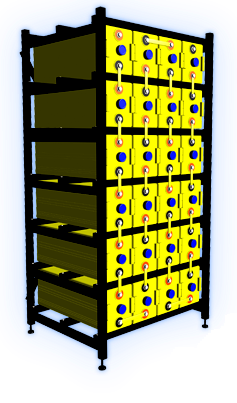Solar Batteries

SEC (Solar Energy Center) Industrial Battery was founded in 1977 par Brian Harper, current president to meet the demand of solar systems. Batteries occupied and still occupy an important part in these systems.

In 1983, SEC changes its strategy and focuses on the production and marketing of stationary batteries SEC realizes a turnover of around 30 million Euros and has 5 subsidiaries around the world.
SEC also has an extensive network of agents (45) worldwide and was the first battery manufacturer to introduce caps on sealed monobloc catalysts.
SEC is one of the few manufacturers in the world to offer a complete battery of different technology :
- Sealed batteries AGM (2 – 6 – 12 Volt 10 with 4500 Ah)
AGM batteries are a type of sealed battery. In an AGM battery, but the electrolyte liquid is held in place by fibers. So there is no risk of leakage and the battery can operate without being perfectly flat. AGM batteries can usually support a large number of cycles and depth of discharge high. They have good resistance to cold. - Sealed batteries GEL (2 – 6 – 12 Volt 20 with 4500 Ah)
Gel batteries are a type of sealed battery. In a gel battery, the electrolyte is gelled. This eliminates the risk of acid leakage in case of breakage and make the battery work in all positions. Gel batteries can usually support a large number of cycles and depth of discharge high. They are more resistant to cold than conventional batteries but less than AGM batteries, they often have good heat resistance and a low rate of self-discharge.
- Batteries Nickel Cadmium of 10 with 1650 Ah - open type elements OpzS
Open battery is a battery with liquid electrolyte caps to fill. Open battery are not waterproof : the liquid that is inside is evaporated little by little, it is necessary to regularly check the level and top up if necessary with distilled water. An open battery can be either : Dryer, a dry battery does not yet contain liquid, it will fill the sulfuric acid before it can be used. Dry batteries have the advantage that they can be transported safely. Especially dry batteries are accepted in aircraft. Wet, a wet battery already contains liquid. Are rarely found wet batteries in commerce because they are dangerous to transport and can not be stored long.



